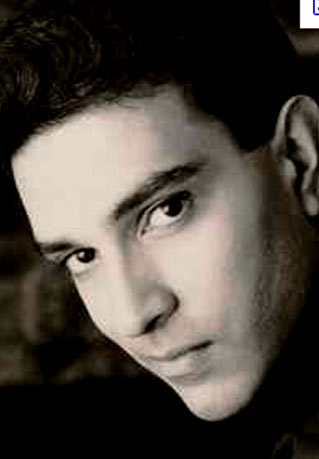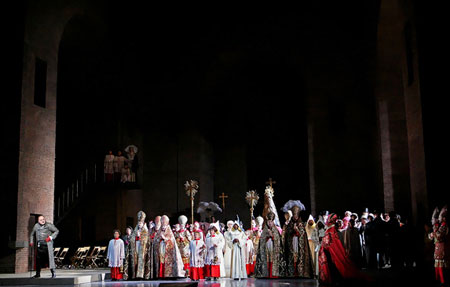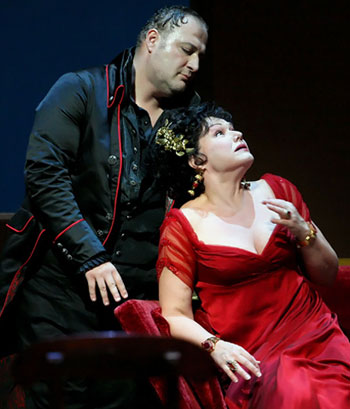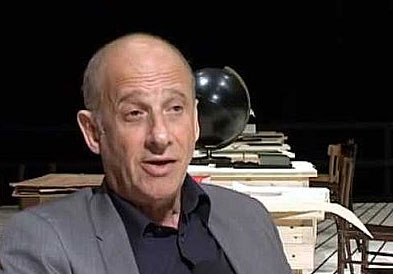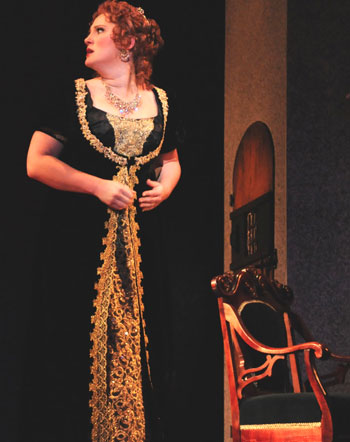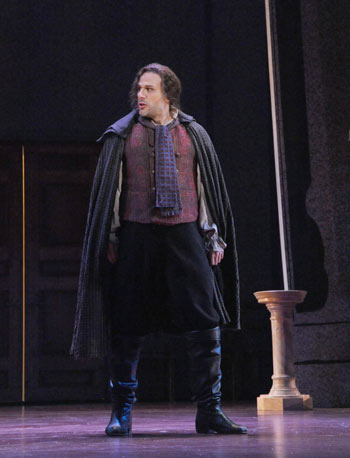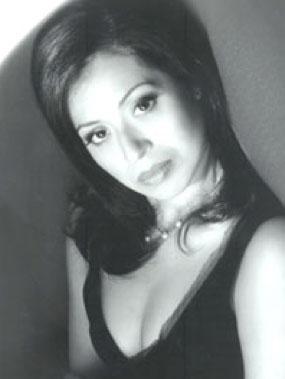No question about it. As of this moment, Puccini’s Tosca is my favorite opera. At its best it has everything you could ask for in an opera. It has Floria Tosca, a beautiful devout heroine who commits murder. It has Baron Scarpia, the very personification of evil. It has Mario Cavaradossi who submits to torture rather than betray his friend. It has spine-chilling climaxes to each of its three acts. And it has Puccini’s music which is not only wonderful in its own right, but which perfectly fits the plot and the action. Not a note is misplaced, not a note is extraneous, not a note is missing. Tosca at its best is THE essential tragic opera.
And yet, Tosca is not like any other opera. In all other operas that I know of, the heroine has things done to her; the drama and appeal of the plot are centered on how she copes. Tosca does something. Musically – and the music alone is enough to justify the opera – musically Cavaradossi, the hero, is a close second in importance. But he is the one to whom things happen, and dramatically he is a distant third to the villain, Scarpia.
I am amazed at how different one Tosca can be from another. After all, the same music and the same words are written down. The director-producer can take some liberties with them, but except for some extreme nuts he/she is limited to shifting an aria from one act to another or imposing a few cuts. But the setting, the costumes, and the lighting can be so different. The nature and quality of the singing and above all the acting can vary so widely. Oh, and let’s not forget the size of the stage, cast, and theatre, as well as if you are seeing it on TV, in a theater on HD, or live (including where you are sitting). And finally, the mysterious whole that arises from all these ingredients has its own essence which may even change from one performance to another of the same cast in the same production depending on such immeasurables as the digestive state of the audience.
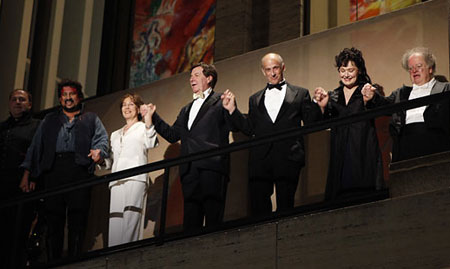
Stars & Notables at Met Gala Opening; note Maestro James Levine extreme R; Photo: Richard Termine/The New York Times
Over the years I have seen many, many productions and performances of Tosca. Four of them, including yesterday’s performance by Opera San Jose, stand out in my memory – and for quite different reasons. Before yesterday, the most recent was the Met HD performance that I went to last year. The other two are by Pocket Opera in 2004 and by West Bay Opera in 2002. Here is what I wrote about that performance shortly after seeing it.
I have to tell you about Julia Kierstine as Tosca with West Bay Opera last October. I may have mentioned before that my ear is incapable of distinguishing between great singing and very good singing. There have probably been stars in big companies who have sung the role even better that she did – I wouldn’t know. But no one could possibly act it better. The plot of Tosca has no surprises for me by now. In the second act I know she is going to pick up a knife and stab Scarpia. But I was on the edge of my seat watching and listening to her. Every line in her face, every muscle in her body showed her going from horror at having to accept Scarpia’s proposition to the final resolve to kill him. Her eyes moving like those of a trapped animal passing over the knife on the table without seeing it; returning to it. Her two hands, white-knuckled, gripping the wine glass as she takes a desperate sip; again; reaching towards the knife and withdrawing; reaching again; putting down the glass and picking up the knife . . . . Even now, I get goose bumps writing about it.
Two years later I sat in my usual front-row seat at the Florence Gould Theatre in San Francisco as Shouvik Mondle sang the role of Scarpia. When he first came on stage, before he even opened his mouth, there was something about his stance, his stride, his face, that simply oozed menace. The most frightening Scarpia in my experience.
Most dramatic operas have a single climax at the end where the hero and/or heroine die. A few, such as Lucia di Lammermoor have two. Tosca certainly has dramatic death climaxes at the end of Acts II and III. But at that Pocket Opera performance I realized that it also had a great musical climax at the end of Act I. Scarpia is singing about his lust for Tosca while the choir in the background is singing a beautiful solemn Te Deum. In almost all other performances the large choir and orchestra dominate the sound and I am peaceful. But somehow Pocket Opera’s 8-piece plus piano orchestra and choir of less than a dozen was in perfect balance with Mondle’s magnificent baritone, and the resulting tension left me limp as the Act ended.
Interestingly, the HD performance last year was the reverse. With the camera mostly showing a close up of Scarpia (and possibly with some sound engineering taking place) the baritone dominated the scene and the enormous choir just provided background music.
Then, there is the final climax at the end of the opera when Tosca flings herself off the tower rather than be captured by Scarpia’s henchmen. There is probably no other one scene in all of opera that has provided so many anecdotes, both comic and tragic, from real life performances. But I’m just writing about performances I have attended, and the one most dramatic ending I have witnessed was in the 2004 performance by Julia Kierstine. Defiant literally until the end, she faced her pursuers and fell off the tower backwards! I only saw her do that once, and part of my gasping reaction was undoubtedly due to surprise. In the long run, Karita Mattila’s leap at the Met may be even more dramatic. Most sopranos disappear behind the tower where invisible stagehands can catch them after a short drop, Mattila leapt more to the side of the stage where we would have seen her fall a much greater distance before being caught out of sight. BUT. The instant her feet left the tower all of the lights went out. Her final cry and the last few notes of the orchestra were done in total darkness. Wow.
I had approached the MetHD performance with mixed feelings since I had heard about the boos which had greeted producer Luc Bondy’s curtain call on opening night (go to Music Review: At the Metropolitan Opera, a Kinky Take on a Classic for the NY Times review). Being prepared for the worst, I was delightfully surprised by a great performance of a fascinating production. All three of the principals were fantastic. Mattila dominated whenever she was on stage and maintained a fiery intensity throughout all three acts. George Gagnidze’s Scarpia was frightening as an all-powerful dirty old man. And Marcelo Alvarez had me thoroughly convinced that Mario Cavaradossi was a real live vital person. I cannot recall seeing or hearing a better Mario.
The backstage interviews of the three stars and the director conducted during intermissions added a real plus to the MetHD performances. Director Luc Bondy said that the primary thing he tried to achieve was emotional realism. He wanted each of the singers to feel, to respond, to act as if they really *were* the character. They all succeeded so well in achieving that aim that I can easily forgive Bondy for the various excesses he committed with some of the details. All three of the singers agreed that with Bondy’s help they were able to really identify with their characters; as Matilla said, “Deep down, I AM Tosca – from the pubic bone on up.”
Well, after all these pages of mostly other Toscas, let’s talk about yesterday’s performance by Opera San Jose. (I think it was Voltaire who first said, “Forgive me for writing you such a long letter; I don’t have time to write a short one”).
Rebecca Davis’ Tosca dominated the stage whenever she was on it. From my seat in the tenth row I couldn’t always make out her facial expression, but her body language put all of her emotions on public display. The audience agreed as almost all of them rose to give her a standing ovation when she came on stage as the final principal during the curtain calls. She is certainly in the same league as Kierstine and Matilla, but I doubt that anyone can recreate the tension in Act II that was the 2002 West Bay Opera Performance. Christopher Bengochea matched her vocally and in acting, but he just doesn’t have as juicy a part.
The minor parts were all solid. The escaped prisoner, Cesare Angelotti appears first, of course. Krassen Karagiozov did a good job of portraying his hunger, his desperation, and his exhaustion.
The Sacristan is usually played as a grumbling, bumbling old man. Isaiah Musik-Ayala’s portrayal as a grumbling younger man was a pleasant change.
These supporting actors are absolutely necessary for the opera, but in a sense the highest praise you can give Michael Mendelsohn as Spoletta, Stephen Boisvert as Sciarrone, and James Cowing as Jailer, is to say you hardly notice them.
I had a chance to chat briefly with Michael Mendelsohn after the performance. I have seen and admired him in many performances including several leading roles. He told me that this was one of his favorite roles. “Even though it is a small part, it is thrilling to feel that I am a part of such a magnificent opera.”
Director Sandra Bengochea inserted some nice little touches. As Puccini’s dramatic overture merges seamlessly into Act I and Angelotti rushes onto the stage, there is a rather long stretch of orchestral music. In other productions I have seen, Angelotti searches and searches for the key to the chapel. Here, his search is interrupted twice by a trio entering the front of the church to kneel, cross themselves, and pray silently. During these interruptions, Angelotti has to abandon his search and hide behind a pillar. Our audience interest in the pantomime was enhanced by the contrast between the two groups. The three nuns were leisurely and stately in all of their actions but the three choirboys who followed ran in, plopped down, crossed themselves zip-zip, mouthed a couple of words, popped up, and ran off.
The other touch I noted was the use of a centrally placed couch in Act II. When Scarpia wants Tosca to see how Cavaradossi is being tortured, he throws her down on the couch which is directly in front of the torture-chamber door. Later, when Tosca has resolved to kill him she lies seductively on the couch and stabs him as he throws himself upon her.
Back in the very beginning of this essay I referred to “Tosca at its best.” This Tosca was very good and well deserved the standing ovation at the end, but it was not Tosca at its best. The basic reason I think was a lack of balance. Davis and Bengochea each had magnificent voices and acting ability; although Torlef Borsting’s Scarpia wasn’t bad, he didn’t match the other two leads in either category. Further, regardless of who was singing, the orchestra’s volume seemed designed to complement the two stars; much of the time this meant that they were playing too loud for the singer(s) on stage. This was particularly egregious during the beautiful shepherd’s song which begins Act III.
It’s not fair of me to be disappointed in the Te Deum at the end of Act I. I have never seen another performance that comes even close to Mondle and the Pocket Philharmonic for 300 of us back in 2004. Perhaps it is impossible to do for large chorus and full orchestra. Indeed, perhaps it is so impossible for a full orchestra that the conductor doesn’t even know that a terrific tension is possible. Anyhow, the bass note on the California Theater’s great organ was sufficient to make Scarpia’s lustful musings inaudible and irrelevant.
All told, the pluses far outweigh the minuses. The good news is that if you live anywhere near San Jose you can see this same production with this same cast on November 20, 26, or 28m. If those dates don’t fit, an alternative cast with the three principal roles taken by Jouvanca Jean-Baptiste (Tosca), Alexander Boyer (Cavaradossi), and Silas Elash (Scarpia) will perform on November 18, 21, 23. If you come to the Sunday matinee on the 21st, look for me in the front row, seat A102.
Ciao,
The Opera Nut
Opera San Jos�
2149 Paragon Drive
San Jose, CA 95131-1312
408-437-4450
California Theatre
345 South First Street
Between San Carlos & San Salvador
Downtown San Jose
This review by Philip G Hodge appeared in sanfranciscosplash.com on November 14, 2010.



